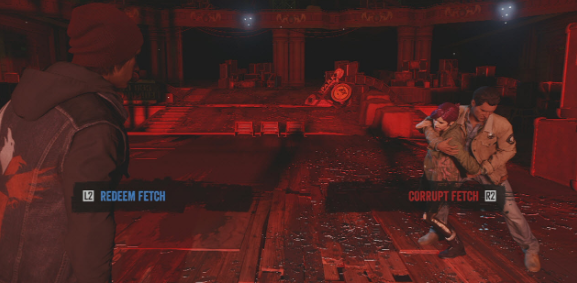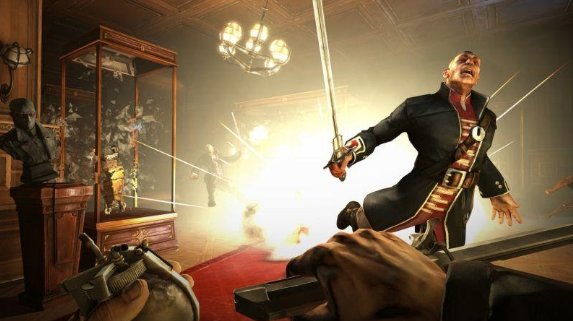Morality in games has been approached from many different angles. It’s a ripe medium to do so since player actions can be either guided or left open to differing effects. By providing feedback on those actions a player can be taught through doing rather than simply through seeing or hearing. However early attempts at addressing a morality system in AAA gaming faced some hiccups.
Games like Infamous and Spiderman: Web of Shadows tackled the issue in a fairly binary manner. The story would progress along with some minimal gameplay differences until some clearly telegraphed choice was presented: “Do you want to be good here or evil?” When you’re prompted with such a choice you’re more likely to choose the option corresponding to which playthrough you’re opting for than to meaningfully engage with the media and learn or express anything. Gameplay on either side of the spectrum is fairly similar and while the narrative might chastise you here or there for your more nefarious actions, it ultimately does revel in what it considers “bad behavior”. At the end of the day, games crafted in this way are about min-maxing your “good” or “evil” score depending on which type of character you want to be. This is pretty obviously not a true reflection of what acting morally or immorally should feel like, let alone making decisions about morality.
Many games have taken this approach, whether blatantly like the aforementioned games or a bit more subtly with dialogue trees or some other equivalent system. Enter Dishonored, a game that not only forces you to engage with its alignment system almost exclusively through gameplay (rather than dialogue trees or prompts) but also one that uses its gameplay, visuals, and several different narrative devices to reinforce its themes such that the player is far more invested and actually learns about a moral viewpoint through the language of games, doing.
In the broad scheme, Dishonored’s morality system pushes forward the idea that using great power to harm others is a moral ill. It suggests that, even given great power and perhaps especially when given great power, one should take the high road, only acting to remove people’s ability to do harm to others, despite any challenges such a path might present . The original game’s tagline is “Revenge Solves Everything”, but the line is more flare than truth when it comes to its overarching message.
In each game something terrible happens to our protagonist at its start, stripping them of the world they once knew. They’re then granted incredible power by the world’s god, The Outsider, and pointed toward those responsible. Outside of that, the player is left to tackle things their own way.
The Outsider serves not only as the enabling tool for the story but also the sounding board for the player’s actions to ensure the moral message is delivered. You encounter him both periodically during main mission content and every time you might go out of your way to his shrines. Should the player take a reckless and violent route, he comes to you unsurprised. He tells of your massacres in horrific detail but ultimately waves them off with some sort of “but what could I expect?” or “they likely deserved it anyway” before vanishing back into the void. However, should you do things in such a way that costs fewer lives he still reminds you that those you seek to punish have done terrible things (further tempting the player down the path of least resistance) but expresses surprise and occasionally even praise at you having managed to avoid bloodshed in your quest. It should also be noted that Outsider shrines are home to runes which grow the player’s power and there’s something to be said about providing moral guidance each time you grow stronger. The system creates a sort of organic method of checking in on the player rather than only providing feedback at regular story beats, and serves to accentuate that player’s personal experience and agency.
This narrative system of rewarding the player for acting particularly moral but remaining unsurprised at immoral behavior more accurately reflects a truth about people who do bad things when faced with adversity in real life, they often don’t see themselves as bad but rather as doing what is necessary or what is owed due to their harsh circumstances, and those around will often be sympathetic to that sentiment and judge them less harshly. It’s only when people rise above what’s expected that people are shocked. However, this message wouldn’t be nearly as effective if the gameplay didn’t also reflect it.
Particularly in Dishonored 1, but also throughout the series, killing is easy and not killing is far more difficult. Combat is satisfying, assassinations are quick, and more tools are offered to do damage than are offered to sneak by unseen and without harming anyone. Killcams zoom in on your carnage, making it an almost hypnotic spectacle. Powers are diverse and multi-faceted letting you toy with your enemies to punish them in creative ways. For a glimpse into how elaborate it can all be, watch any montage of the game on YouTube, it’s developed a whole community around finding spectacular ways to kill people, often in darkly inventive and beautiful ways.
Contrast that glory-filled power fantasy against the far slower and more tense experience of trying to stealthily and peacefully slip through the levels of the game, only occasionally choking someone out and carefully laying their body where they won’t be harmed or cause a commotion and there’s a clear mechanical slant for most people. You’re still able to outwit others with your powers but it’s less of a spectacle and needs to be far more calculated. While many reviews of the game view this as a negative, it’s this exact tension and delaying of gratification (in favor of care) that forces players to practice the skills necessary to succeed in real life.
This experience is perhaps most true with the offerings for how to deal with the main targets of each mission in non-lethal manners. Each mission provides one manner of dealing with your target non-lethally that is far more significant and poetic than simply killing them (which can usually be done swiftly and in a multitude of ways). It allows you to enact some vengeance on them for their actions that often involves a karmic irony striking back at them for their own crimes. This ultimately leaves you feeling more like a conduit for justice than someone acting in their own self interest. This notion is furthered by the fact that you often have to remain unseen and avoid hurting too many other people to even perform the act, sometimes going through some multi-stage preparation to pull it off.
All these choices are made dynamically, too. While there is a tally of how you’ve been acting it’s obscured from the player until each level’s end and it has no real bearing on your abilities. By divorcing your morality score (represented as a “Chaos” level) from your progression, it means there’s no sunk-cost incentive to dive deeper down a path just to earn a flashier powerset so the only reason to strictly adhere to a playstyle besides one’s own taste is for achievements.
As you move through the world acting within it, you ultimately end up acting on it. It begins to change to reflect how you’ve behaved. Should you kill recklessly, the citizens become bleaker and the various plagues of the games worsen with more bodies lining the streets and plague creatures roaming the city. While it will provide little additional challenge or significance to those who are intent on killing and have no intention of engaging more deeply, it provides a powerful incentive for those who are morally inclined, but may not realize they’re being reckless, to adjust their behavior either within the current playthrough or on a subsequent one. It gives players a chance to see the consequences of their actions where games otherwise often teach them to just beat the “bad guy” and move on.
In Dishonored 1 there’s a stark contrast between the final mission should you have a low chaos rating and that same mission if you enter it with a higher one. The entire level’s atmosphere changes, certain parts of the level can be traversed differently, and your encounter with all the key players—including your final contact with the girl you’ve been trying to save throughout the narrative—are drastically different. Just to cap it all off, each game ends by showing how other characters in the game fared in the world after the game’s conclusion, giving the player one final chance to comprehend how their actions might have far reaching consequences in the world around them.
The Dishonored chaos system of expressing morality ties the narrative, gameplay, and world design together to teach the player what it takes to be good and moral. Its themes are carefully interwoven so one’s first playthrough may be an organic representation of their willingness to strive for goodness measured against their need for self-satisfaction and that successive playthroughs can explore the potential of acting more carefully or less carefully than one is accustomed to. All options being viable but only one moral direction being preferred or rewarded allows players to pick any path but still ultimately be guided toward the core moral thesis rather than just be left unaware of what could be.



